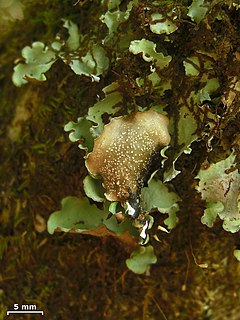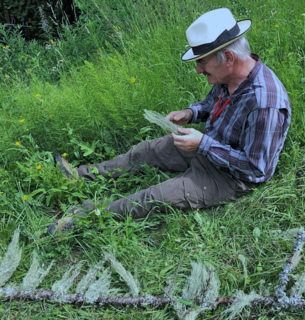Culbersonia is a fungal genus in the family Caliciaceae. This is a monotypic genus, containing the single foliose lichen Culbersonia nubila. This species, which grows on trees and rocks, is found in dry subtropical regions of the world, particularly in Africa and Central America.

Masonhalea is a genus of two species of lichenized fungi in the family Parmeliaceae.
Lethariella is a genus of fruticose lichens in the family Parmeliaceae. The genus was originally proposed as a subgenus of Usnea by Polish lichenologist Józef Motyka in his 1936 monograph of that genus. Norwegian botanist Hildur Krog elevated the taxon to generic status in 1976.

Cetrelia is a genus of leafy lichens in the large family Parmeliaceae. They are commonly known as sea-storm lichens, alluding to the wavy appearance of their lobes. The name of the genus, circumscribed in 1968 by the husband and wife lichenologists William and Chicita Culberson, alludes to the former placement of these species in the genera Cetraria and Parmelia.

Punctelia is a genus of foliose lichens belonging to the large family Parmeliaceae. The genus, which contains about 50 species, was segregated from genus Parmelia in 1982. Characteristics that define Punctelia include the presence of hook-like to thread-like conidia, simple rhizines, and point-like pseudocyphellae. It is this last feature that is alluded to in the vernacular names speckled shield lichens or speckleback lichens.
Chicita Frances Culberson is an American lichenologist.

Thamnolia is a genus of lichens in the family Icmadophilaceae. Members of the genus are commonly called whiteworm lichens.

Menegazzia terebrata is a species of foliose lichen found scattered across many continents, including North America, South America, Europe, Africa, and Asia.

Bryoria is a genus of lichenized fungi in the family Parmeliaceae. Many members of this genus are known as horsehair lichens. The genus has a widespread distribution, especially in boreal and cool temperate areas.

William Louis "Bill" Culberson was an American lichenologist.
Mason Ellsworth Hale, Jr. was one of the most prolific lichenologists of the 20th century. Many of his scholarly articles focused on the taxonomy of the family Parmeliaceae. Hale was one of the first lichen experts to incorporate secondary chemistry and technology such as computers and scanning electron microscopy into taxonomic work. Mason Hale published approximately two hundred articles and books on various aspects of lichen biology including taxonomy, anatomy, chemistry, and ecology. Hale also wrote several books aimed at education and increasing accessibility to lichens.

Yasuhiko Asahina was a Japanese chemist and lichenologist. The standard author abbreviation Asahina is used to indicate this person as the author when citing a botanical name.
Bryoria hengduanensis is a species of lichen of the genus Bryoria. It was described as new to science in 2003 by lichenologists Li-Song Wang and Hiroshi Harada. It is found in the Hengduan Mountains of southern China, where it grows on twigs and branches in coniferous forests at elevations of 3,000–4,000 metres (9,800–13,100 ft). The Hengduan Mountains is a region of high Bryoria biodiversity, as 24 species are known from this area.

Punctelia appalachensis, commonly known as the Appalachian speckled shield lichen, is a species of foliose lichen in the family Parmeliaceae. It is found in the eastern United States and eastern Canada. The lichen was first formally described in 1962 by lichenologist William Culberson as a species of Parmelia. He collected the type specimen growing on tree bark in West Virginia, Hildur Krog transferred it to the newly circumscribed genus Punctelia in 1982.

Punctelia graminicola is a species of foliose (leafy) lichen in the family Parmeliaceae. It grows on rocks, and, less frequently, on bark in North America, South America, and East Africa. It has a blue-grey thallus measuring up to about 15 cm (6 in), covered with tiny pores called pseudocyphellae. Sometimes the lichen forms small lobes that project out from the surface. Fruiting bodies are uncommon in this species; if present, they resemble small cups with a brown internal disc measuring 3–10 mm (0.1–0.4 in) in diameter. A lookalike species, Punctelia hypoleucites, is not readily distinguishable from Punctelia graminicola by appearance or habitat alone; these species can only be reliably differentiated by examining the length of their conidia.

Cetrelia chicitae is a species of foliose lichen in the family Parmeliaceae. It is found in eastern Asia, North America, and Europe, where it grows on mossy rocks and tree trunks.

Cetrelia monachorum is a species of foliose lichen in the family Parmeliaceae. It was first described scientifically in 1930 by Alexander Zahlbruckner as a species of Parmelia. Husband and wife lichenologists William and Chicita Culberson transferred it into the genus Cetrelia in 1977. It is found in Asia, Europe, and North America.

Philippe Clerc is a Swiss lichenologist. A Festschrift was dedicated to him in 2020, on the occasion of his retirement from the Conservatory and Botanical Garden of the City of Geneva, where he worked from 1993 to 2020. Clerc is an authority on the beard lichens, and has had nearly 100 publications on this and other topics, such as the lichen flora of Switzerland.
Geoffrey Charles Bratt was an Australian chemist and lichenologist.













